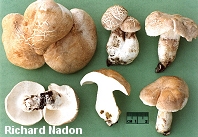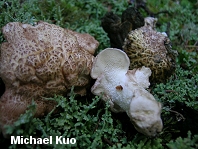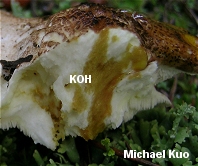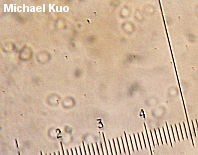| Major Groups > Polypores > Stemmed, Pale-Fleshed > Albatrellus ovinus |

|
Albatrellus ovinus [ Basidiomycetes > Polyporales > Albatrellaceae > Albatrellus . . . ] by Michael Kuo When it decides to be picturesque, Albatrellus ovinus is a pristine-looking white mushroom--but it is often drab and tan, and then it is less distinctive. Members of the genus Albatrellus are polypores, but unlike most of their relatives they are mycorrhizal and thus appear on the ground in the vicinity of trees, rather than on wood. Albatrellus ovinus is found under conifers, and can be recognized by its white to tan cap, which usually develops a cracked appearance; its white to yellowish flesh, which becomes pale olive when dried; its tiny, nearly round spores; and other microscopic features (see below). My collections of Albatrellus ovinus and Albatrellus confluens have come from the Rocky Mountains, where the two species often grow together and can easily be confused once they have matured; I have found that the reaction of the flesh to KOH is very different (golden yellow for Albatrellus ovinus, purple for Albatrellus confluens), and may serve as a way to separate confusing specimens without the bother of microscopic analysis. Description: Ecology: Mycorrhizal with conifers in a wide variety of ecosystems (under Engelmann spruce and subalpine fir in the Rocky Mountains, under Norway spruce and other conifers in the Appalachians, and under various firs, pines, and spruces in northern and northeastern regions); usually growing gregariously (sometimes in dense clusters); summer and fall (also over winter in coastal California, where manzanita is reported, along with conifers, as a host); widely distributed in North America. Cap: 4-20 cm across; usually circular in outline but sometimes irregular; loosely convex, flat, or shallowly depressed in age; rarely fused; dry; smooth at first, usually becoming conspicuously cracked, with pale to yellowish flesh exposed in the cracks; whitish or buff when young, but usually soon tan. Pore Surface: Descending the stem; white to creamy or yellow with age; sometimes bruising faintly greenish or yellowish; pores very small (2-5 per mm) and circular except near the stem in older specimens, where they can become larger and more angular (or even nearly tooth-like); tubes to 4 mm deep. Stem: 3-10 cm long; 1-4 cm wide; central or a little off-center; whitish to tan; smooth or very finely velvety. Flesh: Whitish or yellowish. Odor and Taste: Not distinctive. Chemical Reactions: KOH instantly dirty golden yellow on flesh. Spore Print: White. Dried Specimens: Not typically developing reddish colors on any surfaces; flesh drying yellowish to olive. Microscopic Features: Spores 4-5 x 2.5-3.5 µ; smooth; subglobose or broadly elliptical; inamyloid; walls fairly thick. Gloeoplerous hyphae present, staining in phloxine. Clamp connections absent. REFERENCES: (Schaeffer, 1774) Kotlaba & Pouzar, 1957. (Persoon, 1801 [as Boletus carinthiacus]; Fries, 1821; Saccardo, 1888; Overholts, 1953; Smith, 1975; Smith, Smith & Weber, 1981; Arora, 1986; Gilbertson & Ryvarden, 1986; Phillips, 1991/2005; Lincoff, 1992; Bessette, Miller, Bessette & Miller, 1995; Evenson, 1997; Barron, 1999; Roody, 2003; McNeil, 2006; Miller & Miller, 2006.) Herb. Kuo 09020604. DBG RMNP 2008-064, 2008-108. This site contains no information about the edibility or toxicity of mushrooms. |
© MushroomExpert.Com |
|
Cite this page as: Kuo, M. (2007, April). Albatrellus ovinus. Retrieved from the MushroomExpert.Com Web site: http://www.mushroomexpert.com/albatrellus_ovinus.html |



